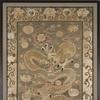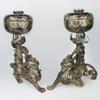Rare Gem With Links to Hope Diamond at Auction
- LONDON, United Kingdom
- /
- September 07, 2015
A rare British-owned gemstone steeped in history and intrigue is to be offered for sale in September for the first time in 98 years.
The Hope Spinel was part of one of the world’s greatest gem collections until its owner – London banker Henry Philip Hope – died in 1839.
It has not been offered for sale since 1917 when it went for £1,060 – the equivalent of £80,000 in today’s money.
Interest is high among collectors, jewellery lovers and those looking to invest in a unique jewel and auctioneer Bonhams is expecting bids in the region of £150,000 to £200,000 for the treasure.
Set in a 19th century silver and gold brooch, the huge 50.13 carats octagonal-cut stone is the size of a small plum and of similar colouring with a splendid rose hue.
A spinel is a gemstone sometimes confused with ruby because they’re found in the same rock formations, are chemically similar and often have a beautiful pinkish-red colouring.
But very large specimens are often more transparent - that is freer from inclusions or “flaws” - than ruby.
The incredible transparency and impeccable cut of the Hope Spinel mean it is classed as an “exceptional treasure” - but its provenance is equally fascinating.
Henry Philip Hope was from a dynasty of incredibly rich and powerful merchant bankers.
By the end of the 18th century the Hope family based in Amsterdam ran one of the most powerful banks in the world.
Hope moved to the UK at the end of the 18th century to escape political upheaval on the continent. He settled in London with his elder brother and they used their tremendous wealth to form important and very valuable art collections.
Hope never married and secretly gifted his collection - including the Spinel and the Hope Blue Diamond, once owned by Sun King Louis XIV - to a nephew to avoid death duties.
Instead, the 700-strong collection became the subject of a decade-long inheritance feud, legal wrangling and bitter recriminations.
The Hope Spinel and several of the most valuable gems were eventually separated from the collection to resolve the issue.
Emily Barber, UK Jewellery Department Director at Bonhams auction house, which is selling the magnificent gemstone on September 24 as part of its London Fine Jewellery sale, explained: “Henry Philip Hope died in 1839 leaving a will but the collection of gems wasn’t mentioned anywhere – he was trying to avoid death duties and hoped it might be kept together.
“He didn’t have any children but he had three nephews and he secretly gifted the collection to one of them during his lifetime.
“After his death, two of his nephews believed they had been gifted the collection which caused ten years of very bitter and very public wrangling over who would inherit the collection.
“Eventually it was decided that the younger nephew Alexander Beresford-Hope would inherit the bulk of the collection. But his elder brother, Henry Thomas Hope, would retain eight of the most valuable stones, including the Hope Blue Diamond and the Hope Spinel.”
On Henry Thomas’s death, the jewels were inherited by his widow, Anne Adele.
Their only daughter was married to a profligate and notorious gambler, the 6th Duke of Newcastle, and she wanted to preserve her husband’s Hope legacy so she bequeathed it to her second grandson, Henry Francis Pelham-Clinton, on condition he assume the Hope surname.
Emily Barber said: “He only really had a lifetime interest and would have needed a court order to sell it. But he was a gambler too and by the mid 1890s, Lord Francis Hope, as he was then known, was declared bankrupt, only nine years after receiving his colossal inheritance.
“He went to court asking to sell some of the collection and he privately sold the Hope Blue Diamond to a dealer in 1901. That now resides in the National Museum of Natural History, part of the Smithsonian Institution, in Washington.
“By 1917, all that remained of the Hope collections were finally dispersed at Christies and the Hope spinel was lot 35 in the sale of ‘The Hope Heirlooms’.
“The spinel was bought by a dealer - it went for £1,060, about £80,000 in today’s money – and it next turned up in the collection of Lady Mount Stephen, who was married to a Canadian philanthropist living in the UK.
“She was a close friend of Queen Mary – the Mount Stephens were very well connected to the British royal family – and gifted a diamond necklace to Queen Mary that Princess Margaret eventually wore on her wedding day.
“When her husband’s great niece was presented at court in the 1920s, she loaned her the Hope Spinel to wear. When Lady Mount Stephen died in 1933, the spinel went to her niece-by-marriage, Elsie Reford, who along with her husband, amassed one of the most important collections of art in Canada. The spinel was gifted to Elsie Refords’ granddaughter, who was also Lady Mount Stephen’s god daughter.
“The current owner is a direct descendant who has always known it as being ‘Aunt Gian’s (Lady Mount Stephen) Hope spinel’.
“There’s a handwritten note in the case describing it as a spinel-ruby from the Hope Collection.”
Emily Barber of Bonhams said: “It not only had the amazing provenance but it’s also an exceptional gemstone in its own right. It’s 50 carats and the actual stone is about two and half centimetres in diameter.
“We’ve had this spinel assessed by SSEF, a premier gemmological laboratory in Switzerland who have confirmed it is from these ancient mines and due to its exceptional transparency, flawless cut, beautiful colour and large size, it’s classed as an exceptional treasure of nature.
“Very large historical specimens were found in the ancient Kuh-i-Lal mines, in Tajikistan. These include the Black Prince’s Ruby and the Timur Ruby both in the Crown Jewels. Both are called rubies when in fact they are spinels.
“The mines are geographically difficult to get to and politically in the 20th century weren’t being used. That makes spinels like these exceptionally rare even without the provenance of the Hope Spinel. It’s a fabulous story; it’s always exciting to re-discover something that has been lost.
“Our estimate for the Hope Spinel is £150,000 to £200,000 but it could go for a lot more. You just don’t see pieces of this quality and provenance on the open market very often. It’s very exciting.”
Emily Barber added: “The original owner, Henry Philip Hope, formed one of the most important private collections of gems in the early 19th century, including more than 700 gem stones, one of which was the Hope Blue Diamond which is now in the National Museum of Natural History, which is part of the Smithsonian.
“Hope arranged his collection scientifically and kept them in a bespoke mahogany cabinet, the treasures of the collection were kept in the 16th drawer and these included: The Hope Diamond, the Hope Pearl (then the largest baroque natural pearl known), an emerald from the turban of Tipu Sultan and this spinel.
“That the spinel and the Hope Diamond were kept together is testament to how important it is and how much Hope valued it.”












![Offering a Truce [Bested], 1895, is estimated to sell for between $1,300,000 and $1,800,000 on March 22, 2014, for The Russell: An Exhibition and Sale to Benefit the C.M. Russell Museum. Offering a Truce [Bested], 1895, is estimated to sell for between $1,300,000 and $1,800,000 on March 22, 2014, for The Russell: An Exhibition and Sale to Benefit the C.M. Russell Museum.](/images/c/a8/20/Dec10_Offering_a_Truce__Bested_300dpi100x100_c.jpg)


